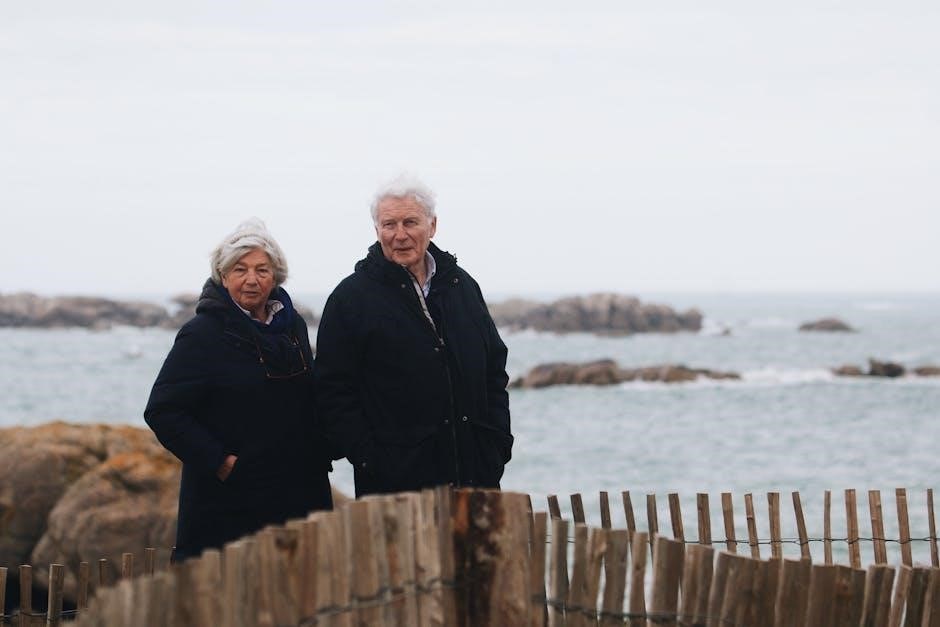
Ernest Hemingway’s The Old Man and the Sea remains a timeless tale of resilience, exploring themes of courage and existentialism. Its PDF version is widely popular, offering readers a convenient way to engage with the novella’s profound narrative. The text includes critical analyses and bibliographical references, enhancing its educational value. Translations, such as the Urdu version by Shahid Hameed, highlight its global appeal and cultural significance.
Background of the Novel
The Old Man and the Sea is a novella by Ernest Hemingway, first published in 1952. It tells the story of Santiago, an aging fisherman, and his epic journey. The novel is set in Cuba and explores themes of perseverance and humanity’s struggle with nature. Hemingway’s concise writing style and focus on existential themes made the book a critical and commercial success. The novella has been translated into multiple languages, including Urdu, as seen in Shahid Hameed’s translation. Its PDF version is widely available, offering readers a convenient way to access this literary masterpiece. The text spans 205 pages, including critical analyses and references, making it a valuable resource for scholars and readers alike.
Publication History
Ernest Hemingway’s The Old Man and the Sea was first published in 1952, marking a significant milestone in his literary career. The novella initially appeared in Life magazine, attracting widespread attention for its concise yet profound storytelling. Its popularity led to a book edition, which included 127 pages and was widely distributed. Over the years, numerous editions have been released, including translations into various languages, such as Urdu by Shahid Hameed. The PDF version has become a popular format for readers, offering accessibility and convenience. The book’s enduring appeal is evident in its continued publication and adaptation into different formats, ensuring its reach to a global audience.
PDF Availability and Popularity
The PDF version of The Old Man and the Sea is widely accessible, making it a popular choice for readers worldwide. Its digital format allows easy distribution and reading on various devices, contributing to its enduring popularity. The novella’s concise length and profound themes make it a favorite among students and literature enthusiasts. Additionally, the PDF includes critical analyses and bibliographical references, enhancing its educational value. Translations, such as the Urdu version by Shahid Hameed, further expand its reach, ensuring Hemingway’s masterpiece remains relevant across cultures and generations. Its availability in PDF has cemented its place as a modern classic in digital literature.

Plot Summary
Ernest Hemingway’s novella tells the story of Santiago, an aging fisherman, and his epic journey to catch a giant marlin, exploring themes of perseverance and loss.
Setting of the Story
The story is set in a small fishing village near Havana, Cuba, where Santiago, the old fisherman, resides. The novella unfolds in the Gulf Stream, a vast, powerful ocean current, which serves as the primary backdrop for Santiago’s journey. The setting is sparse and isolated, emphasizing Santiago’s solitude and his connection to nature. The village represents a community that once celebrated his fishing prowess but now views him as unlucky. In contrast, the sea symbolizes both beauty and brutality, reflecting the duality of life. The setting plays a crucial role in highlighting the themes of man vs. nature and existential struggle, central to the narrative.
Main Plot and Key Events
The novella centers on Santiago, an aging fisherman, who embarks on a journey to break his 84-day streak of bad luck. Accompanied by the young boy Manolin, Santiago ventures far into the Gulf Stream, where he hooks a colossal marlin. The battle between Santiago and the marlin spans days, testing his physical and mental endurance. Despite his exhaustion, Santiago develops a deep respect for the marlin, viewing it as a worthy adversary. Ultimately, Santiago kills the marlin, but his victory is short-lived, as sharks devour the carcass during his return. Santiago arrives ashore with only the marlin’s skeleton, symbolizing both defeat and triumph.
Climax and Resolution
The climax occurs when Santiago, after an arduous battle, harpoons the giant marlin, symbolizing his triumph over nature. However, the resolution unfolds tragically as sharks devour the marlin, leaving only its skeleton. Santiago returns to shore, his journey a testament to perseverance despite loss. The novella concludes with Santiago, though defeated, finding dignity in his struggle, emphasizing the themes of courage and existential acceptance. The PDF version captures this poignant ending, highlighting Hemingway’s mastery in blending human resilience with the inevitability of nature’s dominance.

Themes
The Old Man and the Sea explores profound themes like courage, perseverance, and existentialism. The PDF highlights man’s struggle against nature and the search for life’s meaning through Santiago’s journey.
Courage and Perseverance
Santiago’s journey in The Old Man and the Sea exemplifies unwavering courage and perseverance. Despite enduring 84 days without a catch, he ventures into the Gulf Stream, determined to prove his worth. His battle with the giant marlin, spanning days, showcases his physical and mental resilience. Even when the sharks devour the marlin, Santiago returns with its skeleton, symbolizing his unbroken spirit. The novella highlights how courage is not the absence of fear but the will to persist despite adversity. Santiago’s perseverance reflects Hemingway’s belief in facing life’s challenges with dignity and strength, making him a timeless symbol of human resilience.
Man vs. Nature

In The Old Man and the Sea, the central conflict revolves around Santiago’s epic battle with nature, symbolized by the giant marlin and relentless sharks. Hemingway portrays nature as indifferent yet majestic, testing Santiago’s physical and mental limits. The old man’s journey embodies the human struggle against the uncontrollable forces of the natural world. Despite his respect for nature, Santiago’s determination to conquer the marlin highlights the timeless theme of man vs. nature. The novella explores the idea that while humans may not always prevail, the courage to endure and persevere defines their spirit; This theme resonates deeply, making the PDF version a sought-after resource for literary analysis.
Existentialism and Meaning of Life
Ernest Hemingway’s The Old Man and the Sea delves deeply into existential themes, exploring the search for life’s meaning amidst adversity. Santiago’s journey symbolizes the human struggle to find purpose in an indifferent world. His perseverance despite overwhelming odds reflects the existential belief that meaning is derived from the struggle itself, not the outcome. The novella highlights the idea that life’s significance is found in the act of striving, even in the face of inevitable loss. This philosophical core resonates with readers, making the PDF version a popular resource for exploring these profound existential questions.

Characters
- Santiago, the determined old man, embodies courage and perseverance in his epic struggle.
- The giant marlin symbolizes his ultimate challenge and existential quest.
- Manolin, the devoted young apprentice, represents loyalty and the passing of wisdom.
The novella’s characters, deeply explored in its PDF version, resonate universally, as seen in translations like Shahid Hameed’s Urdu adaptation.
Santiago: The Old Man
Santiago, the aging fisherman, embodies resilience and determination. His journey symbolizes the human struggle against nature and fate. Despite his physical decline, Santiago’s spirit remains unbroken, showcasing his unwavering perseverance. The PDF version of The Old Man and the Sea highlights his character depth, revealing a man driven by hope and experience; Santiago’s relationship with the sea and the marlin reflects his profound connection to nature. His story, widely accessible in PDF format, continues to inspire readers globally, including translations like the Urdu version by Shahid Hameed. Santiago’s tale transcends generations, offering insights into courage, solitude, and the search for meaning.
The Giant Marlin
The Giant Marlin in The Old Man and the Sea symbolizes the ultimate challenge and the power of nature. Santiago’s epic battle with the marlin showcases his determination and skill, while the marlin itself represents an unyielding force of the natural world. The marlin’s enormity and strength highlight the struggle between humanity and the vast, indifferent ocean. Its presence drives the plot, testing Santiago’s physical and mental limits. The marlin’s eventual defeat, though tragic, underscores themes of perseverance and the search for meaning. In PDF versions of the novel, the marlin’s significance is often analyzed, emphasizing its role as both a adversary and a symbol of existential struggle.
The Boy: Manolin
Manolin, the young boy, plays a pivotal role in The Old Man and the Sea, serving as Santiago’s loyal apprentice and friend. Despite his father’s disapproval, Manolin remains devoted to the old man, embodying hope and renewal. Their bond transcends generations, with Manolin symbolizing the future and Santiago the past. The boy’s unwavering support highlights themes of loyalty and interconnectedness. In the PDF version of the novella, Manolin’s character is explored through critical analyses, offering deeper insights into his significance. His presence underscores the idea of shared human experiences, making him a vital element in Santiago’s journey and the story’s emotional depth.

Symbolism
The marlin symbolizes Santiago’s obsession and pride, while the sharks represent destructive forces. Santiago’s journey embodies perseverance and the human struggle against nature’s vastness and indifference.
The Marlin as a Symbol
The giant marlin in The Old Man and the Sea serves as a powerful symbol, representing both nature’s majesty and Santiago’s existential struggle. Its enormous size and beauty embody the uncontrollable forces of nature, while its struggle alongside Santiago mirrors human resilience. The marlin’s eventual skeleton, devoured by sharks, symbolizes the inevitability of loss and the cyclical nature of life. Critical analyses highlight the marlin as a metaphor for Santiago’s quest for meaning and dignity, transcending mere survival. Its presence underscores themes of perseverance and the human condition, making it a central and enduring symbol in Hemingway’s novella.
The Sharks and Their Significance
The sharks in The Old Man and the Sea symbolize the destructive forces of nature and the inevitability of decay. They attack the marlin, reducing it to a skeleton, signifying how nature indifferent to human achievement. The sharks represent the natural order, where life and death coexist. Their relentless pursuit embodies the futility of resisting the inevitable, contrasting Santiago’s perseverance. Despite the marlin’s destruction, Santiago’s journey remains meaningful, highlighting themes of courage and existential acceptance. The sharks serve as a reminder of life’s duality, where triumph and loss are intertwined, reinforcing the novella’s exploration of human resilience in the face of an indifferent world.
Santiago’s Journey as a Symbolic Representation
Santiago’s journey in The Old Man and the Sea is a profound symbolic representation of the human struggle against nature and the search for meaning. His voyage into the Gulf Stream, battling the giant marlin, embodies perseverance and existential reflection. The marlin symbolizes the elusive nature of success, while the sharks represent the inevitability of destruction. Santiago’s journey mirrors life’s challenges, where triumph is fleeting, and loss is inherent. The PDF version of the novella highlights these themes through critical analyses, offering readers a deeper understanding of Santiago’s symbolic quest. His story transcends literal interpretation, becoming a universal metaphor for resilience and the human condition.

Literary Analysis
Hemingway’s concise prose and symbolic depth in The Old Man and the Sea PDF highlight themes of perseverance and existential struggle, resonating universally across cultures and time.
Hemingway’s Writing Style
Ernest Hemingway’s writing style in The Old Man and the Sea is characterized by simplicity, clarity, and a focus on concrete, descriptive details. His minimalist approach creates a direct, unembellished narrative that mirrors the novella’s themes of resilience and existential reflection. Hemingway’s use of short sentences and repetitive structures builds rhythm, emphasizing Santiago’s determination and the relentless natural world. The PDF version of the text preserves this style, allowing readers to experience the sparse yet profound language that has made the work a classic. Hemingway’s ability to convey deep emotional and philosophical complexity through understatement is a hallmark of his craft, making the novella both accessible and intellectually engaging.
Narrative Structure and Technique
Hemingway’s The Old Man and the Sea employs a straightforward yet powerful narrative structure, focusing on Santiago’s solitary journey. The novella is divided into short, concise chapters, reflecting Hemingway’s minimalist style. The story unfolds chronologically, with each day at sea building tension and emphasizing Santiago’s determination. Hemingway’s use of simple, direct language creates an intimate connection between the reader and the old man. The narrative technique often shifts between Santiago’s present struggles and his reflective memories, adding depth to his character. This structure, combined with Hemingway’s iconic iceberg principle, leaves much unsaid, allowing readers to interpret the emotional and symbolic layers of the story. The PDF version preserves this structure, ensuring the narrative’s impact remains intact.
Recurring Motifs and Their Importance
In The Old Man and the Sea, Hemingway employs recurring motifs to enrich the narrative’s depth. The struggle between perseverance and defeat is central, as Santiago’s journey embodies resilience. The marlin symbolizes ambition and the sublime, while the sharks represent inevitable destruction. These motifs underscore existential themes, highlighting humanity’s fragile coexistence with nature. The cyclical nature of life and death is another prominent motif, reflected in Santiago’s journey and the marlin’s fate. These elements weave together to create a universal story of human struggle, making the novella a profound exploration of existence and meaning. The PDF version preserves these motifs, ensuring their timeless relevance.

Historical Context
Published in 1952, The Old Man and the Sea reflects Hemingway’s life experiences and post-WWII cultural shifts. Its themes resonate globally, as seen in translations like the Urdu version by Shahid Hameed, highlighting its universal appeal and enduring relevance in literary history.
Hemingway’s Life and Influences
Ernest Hemingway, born in 1899, was deeply influenced by his adventurous life, including his experiences as a journalist, World War I ambulance driver, and big-game hunter. His love for nature and the sea, reflected in The Old Man and the Sea, stemmed from his passion for deep-sea fishing and time spent in Cuba. Hemingway’s distinctive writing style, characterized by simplicity and clarity, was shaped by his early career in journalism. His personal struggles and philosophical views on life and death also infused his work with existential themes. These influences are evident in the novella, which mirrors his own resilience and fascination with human struggle against nature.
Cultural and Social Background
The Old Man and the Sea reflects the socio-economic struggles of Cuban fishermen, offering insights into their daily lives and the human struggle against nature. The novella’s themes resonate globally, transcending cultural boundaries. Its PDF availability has made it accessible to diverse audiences, fostering cross-cultural understanding. The inclusion of critical analyses and translations, such as the Urdu version by Shahid Hameed, highlights its educational and cultural significance. This accessibility bridges gaps, allowing readers worldwide to connect with Hemingway’s profound exploration of human resilience and existential themes, ensuring the novella’s enduring relevance in modern society.
Historical Relevance of the Novel
The Old Man and the Sea holds significant historical relevance as a reflection of post-World War II human struggle and resilience. Written in 1952, it captures the essence of perseverance during a time of global recovery. The novella’s themes of existentialism and man vs. nature resonate with the broader philosophical debates of the mid-20th century. Its exploration of human dignity and purpose continues to align with historical and cultural shifts, making it a timeless piece. The availability of the novel in PDF format ensures its accessibility for modern readers, preserving its historical and literary significance. This format also includes critical analyses, enriching its educational value and cultural impact.

Reception and Reviews
The Old Man and the Sea received widespread acclaim upon release, earning Hemingway the Pulitzer Prize. Its PDF version remains popular, offering critical insights and enhancing its educational value.
Initial Reception and Critical Response
Upon its release, The Old Man and the Sea received widespread critical acclaim for its concise yet profound storytelling. Critics praised Hemingway’s minimalist style, which conveyed deep emotional and philosophical themes. The novella was seen as a resurgence of Hemingway’s literary prowess, following a period of less favorable reviews for his earlier works. The story’s universal appeal resonated globally, with translations like the Urdu version by Shahid Hameed further broadening its reach. The PDF format has made the novella easily accessible, contributing to its enduring popularity and scholarly analysis, as evident in the 205-page critical anthology that includes bibliographical references and an index.
Modern Interpretations and Reviews
Modern readers and scholars continue to find profound depth in The Old Man and the Sea, praising its universal themes of resilience and existential inquiry. The novella’s concise yet powerful narrative resonates with contemporary audiences, inviting reflections on human struggle and the search for meaning. PDF versions of the book, widely accessible, have introduced Hemingway’s masterpiece to a new generation, sparking fresh discussions about its cultural and philosophical relevance. Critics highlight the novella’s timeless appeal, noting its ability to transcend generations and inspire diverse interpretations. Its enduring popularity underscores Hemingway’s mastery of storytelling and the work’s adaptability to modern literary analysis.
Cultural and Literary Impact
The Old Man and the Sea has left an indelible mark on global literature, transcending cultural boundaries through its universal themes of resilience and existential inquiry. The novella’s PDF version has amplified its accessibility, making it a widely studied and admired work in educational institutions worldwide. Its influence extends beyond literature, inspiring artistic adaptations and philosophical discussions; The inclusion of critical analyses and translations, such as the Urdu version by Shahid Hameed, underscores its cultural adaptability and enduring relevance. As a seminal work, it continues to shape modern literary discourse, ensuring Hemingway’s legacy endures in the digital age.
Adaptations and Interpretations
The novella has inspired various adaptations, including film versions and stage plays, while its PDF format facilitates easy access to interpretations and analyses worldwide.
Film Adaptations
Ernest Hemingway’s The Old Man and the Sea has been adapted into several films, with the most notable being the 1958 version directed by John Sturges, starring Spencer Tracy as Santiago. This adaptation captures the essence of the novella, focusing on the old man’s perseverance and his epic battle with the marlin. Another adaptation, released in 1990, features Anthony Quinn in the lead role, offering a fresh interpretation of Santiago’s journey. Both films emphasize the themes of courage and man versus nature, staying true to Hemingway’s original narrative. These adaptations have helped bring the story to a wider audience, showcasing its timeless appeal and universal themes.
Stage Play Adaptations
Ernest Hemingway’s The Old Man and the Sea has been adapted into stage plays, bringing its poignant themes of perseverance and existentialism to life. These adaptations often emphasize Santiago’s solitary journey, using minimalistic sets to reflect the novella’s simplicity. The stage versions focus on key dialogues and emotional depth, capturing the essence of Santiago’s struggle with the marlin and his internal reflections. Such adaptations provide a unique way to experience the story, allowing audiences to connect with the protagonist’s resilience. The plays are also used in educational settings, helping students analyze the novella’s themes and characters in a dynamic format. This theatrical interpretation enhances the emotional impact of Hemingway’s work.
Artistic and Cultural Interpretations
The Old Man and the Sea has inspired numerous artistic and cultural adaptations, reflecting its universal themes. The novella’s PDF versions, including translations like the Urdu adaptation by Shahid Hameed, demonstrate its global reach. Artists have interpreted Santiago’s journey through paintings and sculptures, symbolizing human struggle and resilience. The story’s simplicity and depth have also influenced filmmakers and playwrights, creating diverse representations. Its cultural impact is evident in how it resonates across languages and mediums, making it a timeless work of art. The PDF format has further amplified its accessibility, allowing readers worldwide to connect with its profound message.

Educational Resources
The PDF version of The Old Man and the Sea serves as a valuable educational resource, offering critical analyses and scholarly insights. It includes bibliographical references and an index, aiding researchers and students in deeper exploration. Translations, such as the Urdu version by Shahid Hameed, expand accessibility for non-English speakers. This format is widely used in classrooms, providing a convenient tool for teaching and learning. Its popularity underscores its significance as a literary and educational resource, making it a key material for studying Hemingway’s work.